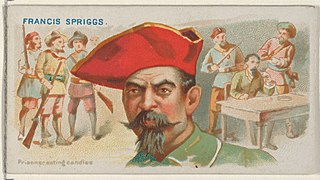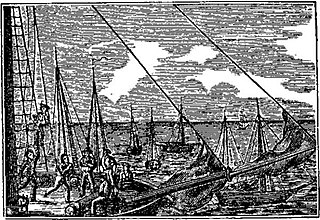
George Lowther (died 1723) was an English pirate who, although little is known of his life, was reportedly active in the Caribbean and Atlantic during the early 18th century. His First Mate was Edward Low.

George Lowther (died 1723) was an English pirate who, although little is known of his life, was reportedly active in the Caribbean and Atlantic during the early 18th century. His First Mate was Edward Low.

Not much is known about him before becoming the 2nd Mate on the slave ship, Gambia Castle, which was under the command of Captain Charles Russell, however Lowther was more popular with the crew, as Russell seemed to care more about his shipment of slaves than for his men. Russell distrusted Lowther, and when he attempted to have him flogged, many crew members took Lowther's side and defended him, causing a schism among the crew.
Also on board, after retreating from their fort, was a Captain Massey, along with a company of soldiers under his command. One night, while Captain Russell was offboard, Massey and Lowther decided to set sail without him. Massey intended to return to England, but Lowther, the crew, and Massey's own soldiers disagreed. Lowther was made captain and he renamed the Gambia Castle, Delivery. They attacked many ships but when Massey wanted to pillage a village on shore, he lost the vote as the risk was deemed too great. Lowther was able to obtain a smaller ship, named the Happy Delivery, and parted ways with Massey and his men.

Lowther left for the Carolinas where he developed the tactic of ramming his ship into another, while his men boarded and looted it. Around 1721 he left for the Grand Caymans where he ran into the Greyhound captained by Benjamin Edwards. Lowther gave a cannon shot for a signal. Greyhound responded with a broadside, (simultaneous discharge of all cannons on a side of a ship.) The pirates boarded the Greyhound, possibly killed the entire crew and burnt the ship. Lowther had many ships under his command by now, granting the 6-gun brigantine Rebecca to his lieutenant Edward Low, who left to begin his own pirate career and with whom Lowther and Francis Spriggs would briefly rejoin in late 1723. [1] When Lowther sailed his fleet to Guatemala they were attacked by natives and he was forced to leave some ships and men behind. His crew and supplies were all transferred to the Revenge.
In 1722 he sailed to a secluded island called Blanquilla. However, before landing he was spotted by Walter Moore, commander of HMS Eagle. Lowther was able to escape to the island by slipping out of his cabin window, along with a dozen crewmen; only four made it to shore. After an extensive search Lowther's body was found. He had shot himself in the head rather than be taken prisoner.
The Post-Boy newspaper dated 2 May 1724 suggested that Lowther may have escaped. The newspaper reports:
"The last Letters from S. Christopher bring Advice, that on the 20th of February, the Eagle Sloop, h ted out from that Island, had brought in thither the Pyrate Sloop she had taken from Lowther, with twenty of the Men that were on board, (Lowther himself and many of the Crew having made their Escape) and it was believed that twelve or thirteen of them would be convicted of Pyracy, and that the others would be clear’d, as being forced into the said Pyrates Service."
The same information is in Newcastle Courant newspaper dated 1 February 1724:
"We have the good News from St. Christophers, that Captain Moor of the Eagle Sloop, discovering a Pyrate Sloop of 10 Guns, and 40 Men, commanded by Lowther, careening at the Island of Blanco, boarded, and took her, with 24 of her Men, but Lowther, and 10 more, jump'd over board, and escap'd, however 4 of them were afterwards taken by a Spanish Cannoe, and 'tis hoped Lowther and the Rest would be also taken."
The Daily Courant of June 12, 1724 reported that "The Master of the Eagle was afterwards informed, that George Lowther, the Captain of the said Pyrate Sloop, had shot himself on the said Island of Blanko, and was found dead with his Pistol burst by his Side." [2]

Bartholomew Roberts, born John Roberts, was a Welsh pirate who was, measured by vessels captured, the most successful pirate of the Golden Age of Piracy. During his piratical career, he took over 470 prize ships. Roberts raided ships off the Americas and the West African coast between 1719 and 1722; he is also noted for creating his own Pirate Code, and adopting an early variant of the Skull and Crossbones flag.

John Rackham, commonly known as Calico Jack, was an English pirate captain operating in the Bahamas and in Cuba during the early 18th century. His nickname was derived from the calico clothing that he wore, while Jack is a nickname for "John".
Captain Benjamin Hornigold (1680–1719) was an English pirate who operated during the tail end of the Golden Age of Piracy.

Thomas Tew, also known as the Rhode Island Pirate, was a 17th-century English privateer-turned-pirate. He embarked on two major pirate voyages and met a bloody death on the second, and he pioneered the route which became known as the Pirate Round. Other infamous pirates in his path included Henry Every and William Kidd.

Stede Bonnet was a Barbadian-born pirate and military officer, known as the Gentleman Pirate for the reason that he was a moderately wealthy landowner before turning to a life of crime. Bonnet was born into a wealthy English family on the island of Barbados, and inherited the family estate after his father's death in 1694. Despite his lack of sailing experience, Bonnet decided he should turn to piracy in the winter of 1716 or spring of 1717. He bought a sailing vessel, the Revenge, and travelled with his paid crew along the Eastern Seaboard of what is now the United States, capturing other vessels and burning other Barbadian ships.

Edward "Ned" Low was a notorious pirate of English origin during the latter days of the Golden Age of Piracy, in the early 18th century. Low was born into poverty in Westminster, London, and was a thief from an early age. He moved to Boston, Massachusetts, as a young man. His wife died in childbirth in late 1719. Two years later, he became a pirate, operating off the coasts of New England and the Azores, and in the Caribbean.

Thomas Anstis was an early 18th-century pirate, who served under Captain Howell Davis and Captain Bartholomew Roberts, before setting up on his own account, raiding shipping on the eastern coast of the American colonies and in the Caribbean during what is often referred to as the "Golden Age of Piracy".

Charles Vane was an English pirate who operated in the Bahamas during the end of the Golden Age of Piracy.

Richard Worley was a pirate who was active in the Caribbean Sea and the East Coast of the American Colonies during the early 18th century.

Francis Spriggs was a British pirate who, associated with George Lowther and Edward Low, was active in the Caribbean and the Bay of Honduras during the early 1720s.
See also 1718 in piracy, 1720 in piracy, 1719 and Timeline of piracy.
Charles Harris (1698-1723) was an English pirate active in the 1720s. He is best known for his association with George Lowther and Edward Low.

John Phillips was an English pirate captain. He started his piratical career in 1721 under Thomas Anstis, and stole his own pirate vessel in 1723. He died in a surprise attack by his own prisoners. He is noted for the articles of his ship, the Revenge, one of only a few complete sets of pirate articles to survive from the so-called Golden Age of Piracy.

The capture of the sloop Ranger was a naval battle which occurred on June 10, 1723 near Block Island in the Atlantic Ocean. Two pirate ships under the command of Englishmen Edward Low and Charles Harris attacked HMS Greyhound, a post ship of the British Royal Navy which they mistook for a civilian whaler. The resulting engagement lasted for several hours and ended with Harris' sloop Ranger being captured by Greyhound while Low's schooner Fancy escaped. All surviving crew of Ranger were captured and brought to Newport, Rhode Island, where they were placed on trial, sentenced to death and executed.

The Battle of Cape Lopez was fought in early 1722 during the Golden Age of Piracy. A Royal Navy ship of the line under the command of Captain Chaloner Ogle defeated the pirate ship of Bartholomew Roberts off the coast of Gabon, West Africa.
Richard Shipton was a pirate active in the Caribbean, best known for sailing alongside Edward Low and Francis Spriggs. In 1723 Shipton was elected captain of Merry Christmas, and he subsequently captained ships such as Royal Fortune, York, and John and Mary. Forced to beach his vessel on western Cuba by pirate hunters, in early 1726, he was found ashore in his bed and presumed to have died shortly afterwards.
Robert Sample was a pirate active off the coast of Africa and in the Caribbean. He is best known for sailing with Edward England.
Robert Lane was a pirate active in the Caribbean and off the coast of Africa. He is best known for sailing with Edward England.

William Lewis was a pirate supposedly active in the Caribbean, off the American east coast, and off the west coast of Africa in the 18th century. He was known for sparing his victims and for being killed after announcing he had made a pact with the Devil. He is likely the fictional creation of "Captain Charles Johnson" who presented his story among those of real historical pirates.
David Williams was a Welsh sailor who turned pirate after being abandoned on Madagascar. He was only briefly a captain, and is best known for sailing under a number of more prominent pirate captains.